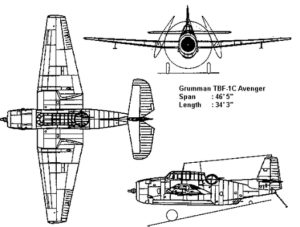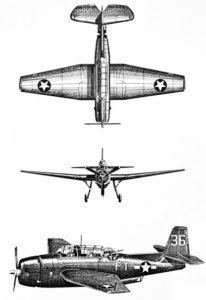The Avenger Torpedo Bomber built during World War II was designated TBF and TBM. They were the same type of aircraft, built two heavy industry companies:
- TBF by Grumman
- TBM by General Motors
During the war GM/Ford/Chrysler didn’t build cars, they built planes, tanks, and jeeps designed by other companies. The Avenger was the first design to feature a new wing-folding mechanism created by Grumman, intended to maximize storage space on an aircraft carrier; the F4F-4 and later models of Wildcat received a similar folding wing and the F6F Hellcat (both designed by Grumman) employed this mechanism as well.

The engine used was the Wright R-2600-20. There were three crew members: pilot, turret gunner and radioman/bombardier/ventral gunner. One .30 caliber machine gun was mounted in the nose, a .50 caliber gun was mounted right next to the turret gunner’s head, in a rear-facing electrically powered turret, and a single .30 caliber hand-fired machine gun mounted ventrally (under the tail), which was used to defend against enemy fighters attacking from below and to the rear. This gun was fired by the radioman/bombardier while standing up and bending over in the belly of the tail section, though he usually sat on a folding bench facing forward to operate the radio and to sight in bombing runs.

Later models of the TBF/TBM dispensed with the nose-mounted gun for one .50 caliber gun in each wing per pilots’ requests for better forward firepower and increased strafing ability. There was only one set of controls on the aircraft, and no access to the pilot’s position from the rest of the aircraft. The radio equipment was massive, especially by today’s standards, and filled the whole glass canopy to the rear of the pilot. The radios were accessible for repair through a “tunnel” along the right hand side. Any Avengers that are still flying today usually have an additional rear-mounted seat in place of the radios, which increases crew to four.
The Avenger had a large bomb bay, allowing for one Bliss-Leavitt Mark 13 torpedo, a single 2,000 pound bomb, or up to four 500 pound bombs. The aircraft had overall ruggedness and stability, and pilots say it flew like a truck, for better or worse. With its good radio facilities, docile handling, and long range, the Grumman Avenger also made an ideal command aircraft for Commanders, Air Group (CAGs). With a 30,000 ft ceiling and a fully-loaded range of 1,000 miles, it was better than any previous American torpedo bomber and better than its Japanese counterpart: the obsolete Nakajima B5N “Kate”.
Later Avenger models carried radar equipment for the ASW and AEW roles. Although improvements in new types of aviation radar were soon forthcoming from the engineers at MIT and the electronic industry, the available radars in 1943 were very bulky, as they contained vacuum tube technology. Because of this, radar was at first carried only on the roomy TBF Avengers, but not on the smaller and faster fighters. Escort carriers sailors referred to the TBF as the “turkey” because of its size and maneuverability in comparison to the F4F Wildcat fighters in CVE air-groups.
On 7 April 1945: Grumman’s TBM torpedo bombers of VT-17 (CAG-17) participated in the sinking of the Japanese Battleship Yamato, in its last desperate run for Okinawa. VT-17 aircraft scored multiplet torpedo hits on the Yamato & sunk one of her destroyer escorts. For their actions in this battle the following squadron personnel were awarded the Navy Cross: Lieutenants T. C. Durkin and S. G. Sullivan; Lt(jg) J. F. Monaghan & Ensign W. F. Nickel. Lieutenant H. E. Clark; Lt(jg) T. J. Coghlan and Ensign R. S. Hanlon were awarded the Silver Star for their actions.
Specifications TBM Avenger
Crew: Three
Length: 40 feet (12.2 m)
Height: 16 feet 5 inches (5 m)
Wingspan: 54 feet (16.5 m)
Empty Weight: 10,843 pounds (4,918.4 kg)
Maximum Weight: 18,250 pounds (8278.2 kg)
Powerplant: One Wright/Cyclone R-2600-20 with 1,900 horsepower 14 cylinder, air-cooled
Maximum Range: 1,130 miles with torpedo; 1,920 miles as scout aircraft
Maximum Speed: 267 m.p.h. at 16,000 feet;
Service Ceiling: 23,400 feet
Defensive Armament: Two wing-mounted .50 caliber Colt-Browning M2 machine guns with 335 rounds per gun; one turret-mounted .50 caliber Colt machine gun with 400 rounds; & one tail mounted .30 caliber machine gun with 500 rounds;
Offensive Armament: In bomb bay: one 22.4 inch Bliss-Leavitt Mark 13 torpedo or Max. 2000 pounds of bombs or depth charges. Eight under-wing mounted 5-inch rockets.
(This page is a work in progress)


 Donations appreciated.
Donations appreciated.